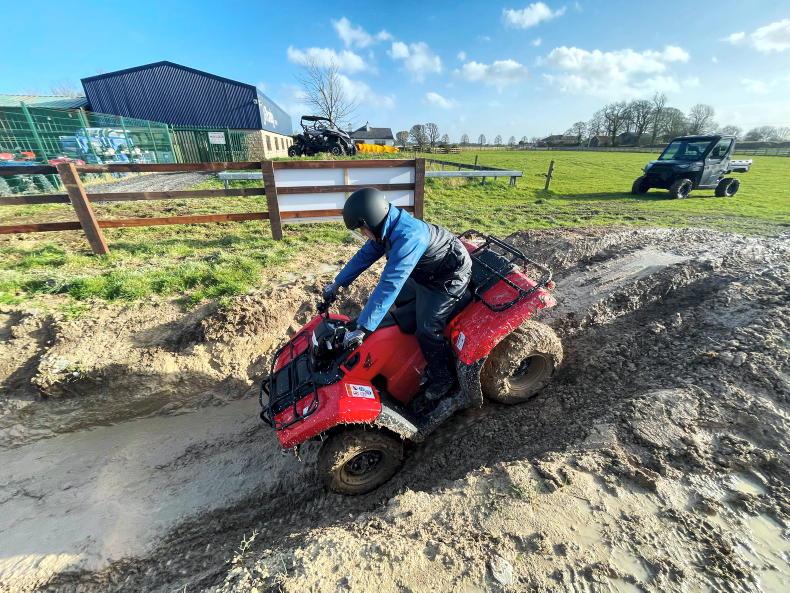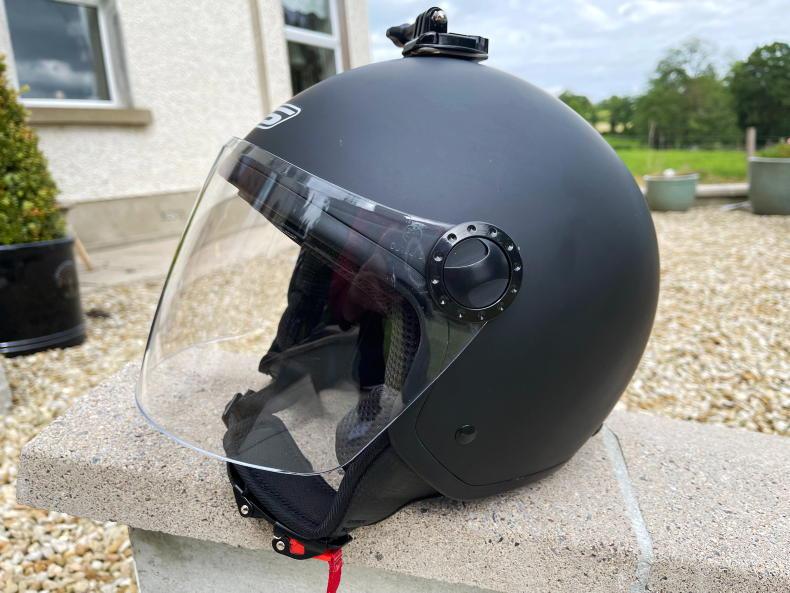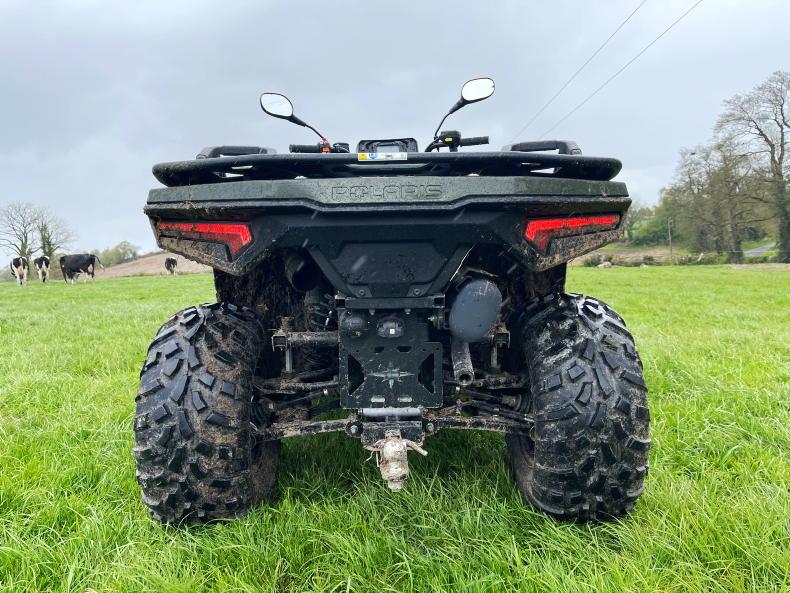Quad bikes, or All-Terrain Vehicles (ATVs) as they’re technically referred to, continue to grow in popularity on Irish farms. A quad, once
operated correctly and safely, is a great tool on any farm for herding cattle or other work duties such as spraying, fertiliser spreading or pulling a trailer. However, once in the wrong hands and incorrectly used, a quad quickly becomes a very dangerous piece of machinery.
Although a farm quad may seem like a simple machine to operate, they are intended for use by riders over 16 years of age. So, for your own safety and the safety of others, it’s important this age restriction is followed.
However, if you’re under 16, it doesn’t mean that you should stop reading at this point. Now is a great time to familiarise yourself with the recommended safety advice that should be considered, so that when the time comes, you can get behind the handlebars straightaway.
Remember, a farm quad is not a toy and has the ability to cause serious injury or harm in a split second. Over the five-year period from 2017 to 2021, there were 40 vehicle-related fatalities on Irish farms. Of these fatalities, 21 involved tractors and seven involved quad bikes.
PPE
First and foremost, wearing the correct personal protective equipment (PPE) is vital. The wearing of a helmet is a must before taking control of a quad.
Wearing a helmet will significantly reduce the risk of a serious head injury in the event of an accident. As a rider, you should always wear an approved helmet and not the likes of a bicycle helmet. A helmet should fit your head comfortably and securely.

When riding on a side slope,keep your weight on the uphill side by leaning sideways.
If there’s a quad on your farm and no helmet, you should convince the quad owner to buy one – after all, a good helmet will only cost €50-70. Wearing a helmet with a face shield or goggles protects your eyes and will help your vision.
Maintenance and safety checks
All quads are designed to cope with rough terrain, but like every machine they have their limits. Once used outside these limits, they can quickly become unstable.
Before riding, it is mandatory that the rider spends time understanding the quad, its parts and capabilities, as well as the legal requirements.

While travelling down a steep slope transfer your weight to the rear of the quad.
All the usual pre-start checks such as tyre pressures, brakes, fluid levels (engine oil, etc) and lights should be carried out. If you are unsure about any of this, ask a parent, older sibling or the quad owner.
It’s important that front and rear cargo rack weight limits are never exceeded. These weights will generally be displayed on the quad’s body panels and are typically in the region of 45-50kg in front and 85-95kg on the rear, although these vary between manufacturers. Once again, if unsure ask somebody who knows.
Control and passengers
You might think riding a quad is as simple as sitting upright and just driving, however this is not the case if the quad is to be ridden properly and safely.
As a rule of thumb, there should never be a passenger present on the quad with the rider. Although the seat may look as if it could carry a passenger, it is not designed to do so. The reason for the long seat is so that the rider can move their body weight forward and backwards while riding in hilly and sloped terrain.

A helmet must always be worn while riding a quad.
A rider’s body positioning has a huge influence on the quad’s stability. As a rider, you must have the ability to counteract the momentum of the quad.
In simple terms, lean backward while travelling down a steep slope, lean forwards climbing a slope and lean upwards while on a side slope, which should be avoided where possible.
Similarly, you should always lean into a corner while keeping your feet grounded.
ATV handling
This brings us on to handling. When a quad has its front or rear racks loaded, then the handling of the quad will be completely different and unbalanced, especially when it comes to cornering and braking.

Before use, the quad should be quickly checked over ensuring it is safe to operate.
For example, a 100l weed sprayer, which is quite common, exceeds the rear capacities of most ATVs. In most cases, this will leave the quad’s handling extremely poor due to being unbalanced.
Incoming rules
In 2023, possibly by the time you are old enough to ride the farm quad, you and all riders young and old will likely have to take part in a mandatory training course and wear the mandatory PPE.
These courses are excellent, as they show and explain all the do’s and don’ts for the safe use of quads.
Are you old enough to ride? Do you have a knowledge of the machine and its limits?Do you know how to operate the quad safely? Have you the correct personal protective equipment (PPE?)
Quad bikes, or All-Terrain Vehicles (ATVs) as they’re technically referred to, continue to grow in popularity on Irish farms. A quad, once
operated correctly and safely, is a great tool on any farm for herding cattle or other work duties such as spraying, fertiliser spreading or pulling a trailer. However, once in the wrong hands and incorrectly used, a quad quickly becomes a very dangerous piece of machinery.
Although a farm quad may seem like a simple machine to operate, they are intended for use by riders over 16 years of age. So, for your own safety and the safety of others, it’s important this age restriction is followed.
However, if you’re under 16, it doesn’t mean that you should stop reading at this point. Now is a great time to familiarise yourself with the recommended safety advice that should be considered, so that when the time comes, you can get behind the handlebars straightaway.
Remember, a farm quad is not a toy and has the ability to cause serious injury or harm in a split second. Over the five-year period from 2017 to 2021, there were 40 vehicle-related fatalities on Irish farms. Of these fatalities, 21 involved tractors and seven involved quad bikes.
PPE
First and foremost, wearing the correct personal protective equipment (PPE) is vital. The wearing of a helmet is a must before taking control of a quad.
Wearing a helmet will significantly reduce the risk of a serious head injury in the event of an accident. As a rider, you should always wear an approved helmet and not the likes of a bicycle helmet. A helmet should fit your head comfortably and securely.

When riding on a side slope,keep your weight on the uphill side by leaning sideways.
If there’s a quad on your farm and no helmet, you should convince the quad owner to buy one – after all, a good helmet will only cost €50-70. Wearing a helmet with a face shield or goggles protects your eyes and will help your vision.
Maintenance and safety checks
All quads are designed to cope with rough terrain, but like every machine they have their limits. Once used outside these limits, they can quickly become unstable.
Before riding, it is mandatory that the rider spends time understanding the quad, its parts and capabilities, as well as the legal requirements.

While travelling down a steep slope transfer your weight to the rear of the quad.
All the usual pre-start checks such as tyre pressures, brakes, fluid levels (engine oil, etc) and lights should be carried out. If you are unsure about any of this, ask a parent, older sibling or the quad owner.
It’s important that front and rear cargo rack weight limits are never exceeded. These weights will generally be displayed on the quad’s body panels and are typically in the region of 45-50kg in front and 85-95kg on the rear, although these vary between manufacturers. Once again, if unsure ask somebody who knows.
Control and passengers
You might think riding a quad is as simple as sitting upright and just driving, however this is not the case if the quad is to be ridden properly and safely.
As a rule of thumb, there should never be a passenger present on the quad with the rider. Although the seat may look as if it could carry a passenger, it is not designed to do so. The reason for the long seat is so that the rider can move their body weight forward and backwards while riding in hilly and sloped terrain.

A helmet must always be worn while riding a quad.
A rider’s body positioning has a huge influence on the quad’s stability. As a rider, you must have the ability to counteract the momentum of the quad.
In simple terms, lean backward while travelling down a steep slope, lean forwards climbing a slope and lean upwards while on a side slope, which should be avoided where possible.
Similarly, you should always lean into a corner while keeping your feet grounded.
ATV handling
This brings us on to handling. When a quad has its front or rear racks loaded, then the handling of the quad will be completely different and unbalanced, especially when it comes to cornering and braking.

Before use, the quad should be quickly checked over ensuring it is safe to operate.
For example, a 100l weed sprayer, which is quite common, exceeds the rear capacities of most ATVs. In most cases, this will leave the quad’s handling extremely poor due to being unbalanced.
Incoming rules
In 2023, possibly by the time you are old enough to ride the farm quad, you and all riders young and old will likely have to take part in a mandatory training course and wear the mandatory PPE.
These courses are excellent, as they show and explain all the do’s and don’ts for the safe use of quads.
Are you old enough to ride? Do you have a knowledge of the machine and its limits?Do you know how to operate the quad safely? Have you the correct personal protective equipment (PPE?) 









 This is a subscriber-only article
This is a subscriber-only article










SHARING OPTIONS: